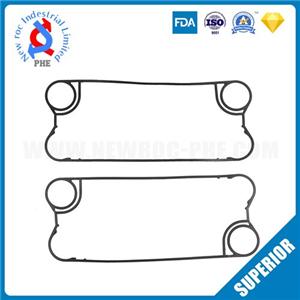Material description of main components of plate heat exchanger
From the development history of plate heat exchangers, we can easily see that the ultimate goal of each improvement is to improve the heat exchange efficiency between the media. In the early stage of the development of the plate heat exchanger, due to the limitation of the technical level, the development of the plate heat exchanger is mainly the structure and plate shape, which is calculated and analyzed through thermal experiments. After entering the modern era, the development of plate heat exchangers focuses on the selection of component materials and the optimization of structural details.
Plate heat exchanger's heat exchanger plate material and main application conditions
1. Stainless steel heat exchanger plates are mainly used in water purification, river water, edible oil, minerals and other conditions;
2. Titanium and titanium-palladium heat exchanger plates are mainly used in conditions such as dilute sulfuric acid and inorganic aqueous solutions;
3. Nickel heat exchanger plates are mainly used in conditions such as high temperature and high concentration of caustic soda;
4. Hastelloy heat exchanger plates are mainly used in conditions such as concentrated sulfuric acid and inorganic aqueous solutions;
5. Molybdenum heat exchanger plates are mainly used in conditions such as dilute sulfuric acid and inorganic aqueous solutions;
6. Graphite heat exchanger plates are mainly used in conditions such as hydrochloric acid, medium concentration sulfuric acid, phosphoric acid, and hydrofluoric acid;
Heat exchanger gasket material and main application conditions of plate heat exchanger
1. Nitrile rubber heat exchanger gaskets can withstand the highest temperature between 110 degrees and 140 degrees, mainly used in water, sea water, mineral water, salt water and other conditions;
2. EPDM heat exchanger gaskets can withstand the highest temperature between 150 degrees and 170 degrees, which are mainly used in hot water, steam, acid, alkali and other conditions;
3. The fluororubber heat exchanger gasket can withstand the highest temperature of 180 degrees, which is mainly used in high temperature water, acid, alkali, organic solvent and other conditions;
4. The chloroprene heat exchanger gasket can withstand the highest temperature of 130 degrees, which is mainly used in acid, alkali, mineral, lubricating oil and other conditions;
5. Silicone heat exchanger gaskets can withstand the highest temperature between 180 degrees and 220 degrees, mainly used in food, oil, fat, alcohol and other conditions;
6. Asbestos rubber heat exchanger gasket, the highest temperature it can withstand is 260 degrees.
The material of the frame plate of the plate heat exchanger
1. The standard heat exchanger frame plate material is generally carbon steel;
2. The special heat exchanger frame plate material is semi-stainless steel or all stainless steel.
Plate heat exchanger interface material
1. The standard heat exchanger interface material is stainless steel bushing;
2. Special heat exchanger interface materials, such as nitrile rubber, EPDM, Hastelloy, titanium and other alloys.




